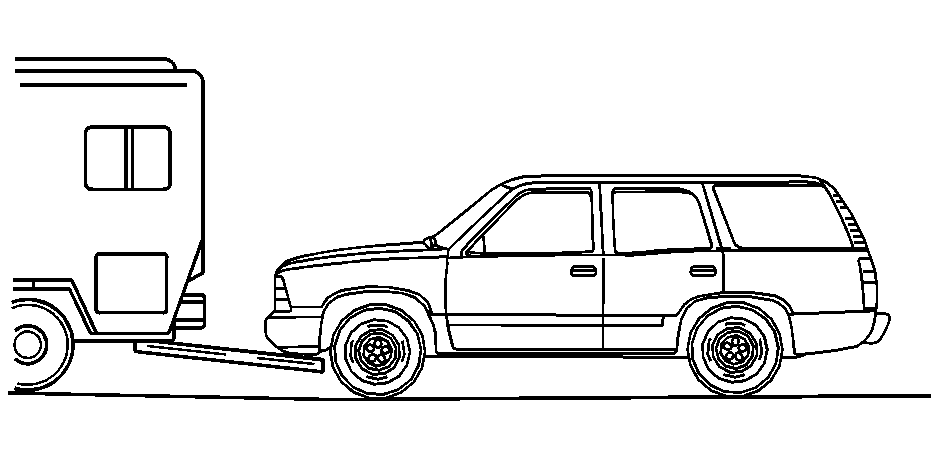Recreational vehicle towing means towing your vehicle behind another vehicle - such as behind a motorhome. The two most common types of recreational vehicle towing are known as "dinghy towing" (towing your vehicle with all four wheels on the ground) and "dolly towing" (towing your vehicle with two wheels on the ground and two wheels up on a device known as a "dolly").
With the proper preparation and equipment, many vehicles can be towed in these ways. See "Dinghy Towing" and "Dolly Towing," following. You may also need brakes for the vehicle being towed. See your dealer for additional trailering information.
Here are some important things to consider before you do recreational vehicle towing:
| • | What's the trailering capacity of the towing vehicle? Be sure you read the tow vehicle manufacturer's recommendations. |
| • | How far will you tow? Some vehicles have restrictions on how far and how long they can be towed. |
| • | Do you have the proper towing equipment? See your dealer or trailering professional for additional advice and equipment recommendations. |
| • | Is your vehicle ready to be towed? Just as you would prepare your vehicle for a long trip, you'll want to make sure your vehicle is prepared to be towed. See Before Leaving on a Long Trip . |
Dinghy Towing

When towing your vehicle, turn the ignition off.
Two-Wheel-Drive Vehicles
Notice: If the vehicle is towed with all four wheels on the ground, the drivetrain components could be damaged. The repairs would not be covered by the vehicle warranty. Do not tow the vehicle with all four wheels on the ground.
Two-wheel-drive vehicles should not be towed with all four wheels on the ground. Two-wheel-drive transmissions have no provisions for internal lubrication while being towed. To properly tow these vehicles, they should be placed on a platform trailer, or dolly towed. See "Dolly Towing" following for more information.
Four-Wheel-Drive Vehicles
Four-wheel-drive vehicles can be dinghy towed if you follow the proper procedures. The transmission has no provisions for internal lubrication while being towed, so it is important that you follow all the steps listed in this manual to dinghy tow your four-wheel-drive vehicle.
Use the following procedure to tow your vehicle:
- Shift the transmission to PARK (P).
- Turn the engine off, but leave the ignition on.
- Firmly set the parking brake.
- Securely attach the vehicle being towed to the tow vehicle.
- Shift the transfer case to NEUTRAL (N). See Four-Wheel Drive for the proper procedure to select the NEUTRAL (N) position for your vehicle.
- Release the parking brake only after the vehicle being towed is firmly attached to the towing vehicle.
- Turn the ignition off.
Caution: Shifting a four-wheel-drive vehicle's transfer case into N (Neutral) can cause the vehicle to roll even if the transmission is in P (Park). The driver or others could be injured. Make sure the parking brake is firmly set before the transfer case is shifted to N (Neutral).
Dolly Towing
Two-Wheel-Drive Vehicles
Two-wheel-drive vehicles should not be dolly towed . Two-wheel-drive transmissions have no provisions for internal lubrication while being towed. To properly tow these vehicles, they should be placed on a platform trailer with all four wheels off the ground.
Four-Wheel-Drive Vehicles
Four-wheel-drive vehicles can be dolly towed with the rear wheels on the ground.
Use the following procedure to tow your vehicle:
- Drive the vehicle onto the tow dolly.
- Shift the automatic transmission to PARK (P).
- Turn the engine off, but leave the ignition on.
- Firmly set the parking brake.
- Securely attach the vehicle being towed to the dolly.
- Shift the transfer case to NEUTRAL (N). See Four-Wheel Drive for the proper procedure to select the NEUTRAL (N) position for your vehicle.
- Release the parking brake only after the vehicle being towed is firmly attached to the towing vehicle.
- Turn the ignition off.
Caution: Shifting a four-wheel-drive vehicle's transfer case into N (Neutral) can cause the vehicle to roll even if the transmission is in P (Park). The driver or others could be injured. Make sure the parking brake is firmly set before the transfer case is shifted to N (Neutral).
